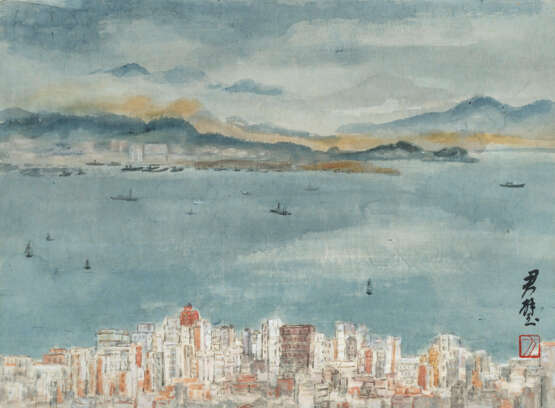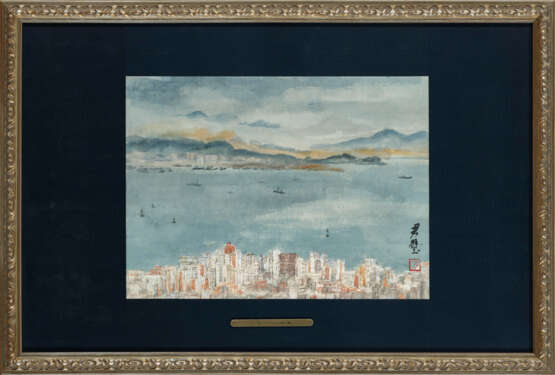ID 965837
Lot 251 | FAN TCHUNPI (FANG JUNBI, 1898-1986)
Valeur estimée
HKD 80 000 – 120 000
Hong Kong Harbor
signed in Chinese (lower right)
ink and gouache on paper
32.5 x 44 cm. (12 3/4 x 17 3/8 in.)
Painted in 1960-1970s
one seal of the artist
Provenance
Collection of the artist
Thence by descent to the present owner
Post lot text
Fan Tchunpi (1989-1986) was born to a prominent family in Fujian. In 1912, the artist accompanied members of the Fang family who had been awarded government scholarships on their travel to study overseas. Fan arrived in France at the age of 14 and lived with her elder sister in the commune of Montargis, where a large group of Chinese students including Cai Yuanpei resided. Fan was mentored by Cai on Chinese, calligraphy and poetry, and she developed a solid foundation in Chinese classical studies that would later become a major influence in her paintings. In 1920, Fan gained admission to the École nationale supérieure des Beaux-arts de Paris by examination and became the first Chinese female student ever accepted into that school. It marked the beginning of Fan’s artistic career.
Painted in 1924, Peaches bears the imprint of Fan’s artistic training in the 1920s. From the use of colours to the light and shadow, the painting resonates with a touch of French-infused romance of a common subject matter in Western paintings. The peaches appear plump and radiant, while the green leaves on the table make the fruits look even more luscious, which accentuates the delicate brushwork and highlights the artist’s command of painting techniques. Among the Chinese painters who studied overseas in the early 20th century, the question of how to merge the quintessence of Chinese and Western paintings was a much-contemplated one. Fan was no exception. After 1925, Fan studied traditional ink painting with Gao Jianfu and Gao Qifeng, leading figures of the Lingnan School. She proposed the concept of Chinese sketch painting and began her experiment of combining Chinese and Western painting techniques in her practice. Her distinctive blend of Chinese and Western painting techniques received high praise from Cai Yuanpei. Painted in 1936, Old Tree by Stream reflects a shift in the artist’s mindset after she took up Chinese painting. The old tree standing erect encapsulates the strength of the artist’s character. Be it the tree trunks or the rocks by the stream, the images are enriched with the texturing technique that is characteristic of Chinese landscape painting, while the scenery embodies a unison of Chinese and Western philosophies. In 1943, Fan met Qi Baishi and painted a portrait of the elderly artist, employing her unique mix of Western painting techniques and Chinese painting materials. In exchange, Qi carved a zhuwen (red characters) seal for Fan. Fan was extremely fond of it, and used it on most of the colour ink paintings that she created with Chinese mediums from then on. It also became an important marker in determining the authenticity and dates of Fan’s works. In 1949, Fan left mainland China and returned to France with her three children after a brief stay in Hong Kong. Once the starting point for her artistic journey, the French art scene had gone through cataclysmic changes. The transition proved to be challenging for Fan, who found herself losing confidence in her artistic practice. She considered giving up painting at one point, but her passion for the art drew her back to the brush. She was determined to steer away from the artistic trends of the time and follow her own path.
In 1972, Fan returned to China after having resided in the States for years, and she had a reception with the then Premier Zhou Enlai. Fan spent the following year travelling across the country, at last experiencing China in reality rather than in imagination. The experience is manifested in her works from this period, which feature a more realistic style, everyday subjects, and vibrant colours. Painted in 1973, Peach Blossoms, Beijing is one of the works from this period. As reflected in the choice of ink as the medium, the artist had moved beyond the confines of oil painting. The blooming peach blossoms spell the artist’s love for her homeland, while the tile roofs of old houses evoke the atmosphere of everyday life of the people of China. In traditional landscape painting, the sky is usually rendered as a blank. In this painting, the artist draws on the colouring techniques in Western paintings to create delicate and shifting textures. The blossoming flowers and the courtyard houses of Beijing resound with a humanistic spirit that encompasses Eastern and Western sensibilities. On the journey across her homeland, Fan travelled from the north to the east. In Hong Kong Harbor, the Hong Kong Island is teeming with skyscrapers, calling to mind the city’s glory as the Pearl of the Orient. On the other side of the harbour lie luxuriant mountains across the Kowloon Peninsula. Since the 1990s, the Victoria Harbour has gone through a series of reclamation works due to insufficient land supply in the city, and the sight of a wide harbour is now a memory. Created in the 1960s to 1970s, the painting is not only a delicate portrayal of the bustling city, but also a precious record of the once-expansive Victoria Harbour. In 1978, the University of Hong Kong held the Fan Tchunpi Retrospective Exhibition in celebration of the establishment of the Department of Fine Arts, and brought the artist’s work to the Hong Kong audience. In 1984, two years before the artist’s passing, Musée Cernuschi in Paris held a retrospective, Fan Tchunpi, Contemporary Chinese Artist: 60 Paintings or 60 Years in Painting. It was an immense compliment on an affirmation of the achievement of this gentle and resilient artist from the East.
| Technique appliquée: | Gouache |
|---|---|
| Matériel: | Verre acrylique, Plastique |
| Lieu d'origine: | Chine, Asie de l'Est, Asie |
| Catégorie maison de vente aux enchères: | Peintures |
| Technique appliquée: | Gouache |
|---|---|
| Matériel: | Verre acrylique, Plastique |
| Lieu d'origine: | Chine, Asie de l'Est, Asie |
| Catégorie maison de vente aux enchères: | Peintures |
| Adresse de l'enchère |
CHRISTIE'S 18 Chater Road Central Hong Kong Hong Kong | ||||||||||||||
|---|---|---|---|---|---|---|---|---|---|---|---|---|---|---|---|
| Aperçu |
| ||||||||||||||
| Téléphone | +85227601766 | ||||||||||||||
| Fax | +852 2760 1767 | ||||||||||||||
| Conditions d'utilisation | Conditions d'utilisation | ||||||||||||||
| Heures d'ouverture | Heures d'ouverture
|








